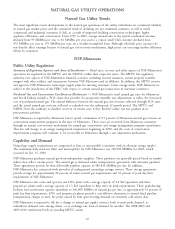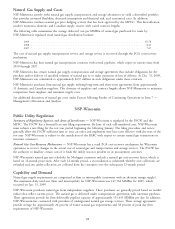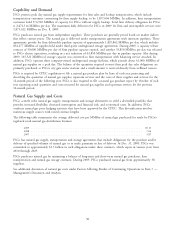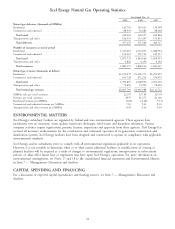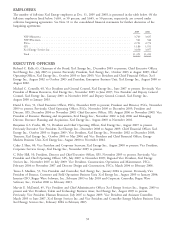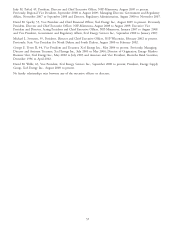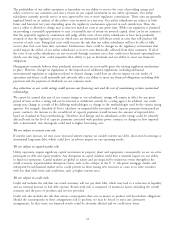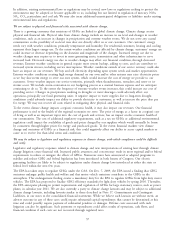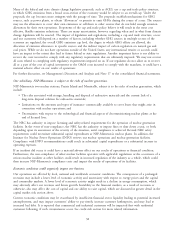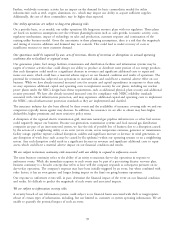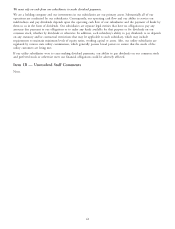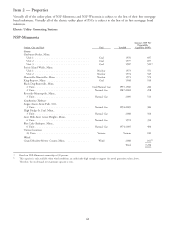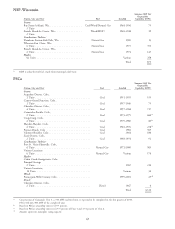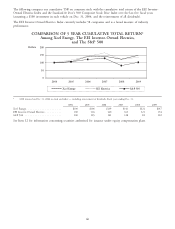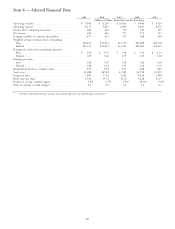Xcel Energy 2009 Annual Report Download - page 47
Download and view the complete annual report
Please find page 47 of the 2009 Xcel Energy annual report below. You can navigate through the pages in the report by either clicking on the pages listed below, or by using the keyword search tool below to find specific information within the annual report.In addition, existing environmental laws or regulations may be revised, new laws or regulations seeking to protect the
environment may be adopted or become applicable to us, including but not limited to regulation of mercury, NOx,
SO2, CO2, particulates and coal ash. We may also incur additional unanticipated obligations or liabilities under existing
environmental laws and regulations.
We are subject to physical and financial risks associated with climate change.
There is a growing consensus that emissions of GHGs are linked to global climate change. Climate change creates
physical and financial risk. Physical risks from climate change include an increase in sea level and changes in weather
conditions, such as an increase in changes in precipitation and extreme weather events. We do not serve any coastal
communities so the possibility of sea level rises does not directly affect us or our customers. Our customers’ energy
needs vary with weather conditions, primarily temperature and humidity. For residential customers, heating and cooling
represent their largest energy use. To the extent weather conditions are affected by climate change, customers’ energy use
could increase or decrease depending on the duration and magnitude of the changes. Increased energy use due to
weather changes may require us to invest in more generating assets, transmission and other infrastructure to serve
increased load. Decreased energy use due to weather changes may affect our financial condition, through decreased
revenues. Extreme weather conditions in general require more system backup, adding to costs, and can contribute to
increased system stresses, including service interruptions. Weather conditions outside of our service territory could also
have an impact on our revenues. We buy and sell electricity depending upon system needs and market opportunities.
Extreme weather conditions creating high energy demand on our own and/or other systems may raise electricity prices
as we buy short-term energy to serve our own system, which would increase the cost of energy we provide to our
customers. Severe weather impacts our service territories, primarily when thunderstorms, tornadoes and snow or ice
storms occur. We include storm restoration in our budgeting process as a normal business expense and we anticipate
continuing to do so. To the extent the frequency of extreme weather events increases, this could increase our cost of
providing service. Changes in precipitation resulting in droughts or water shortages could adversely affect our
operations, principally our fossil generating units. A negative impact to water supplies due to long-term drought
conditions could adversely impact our ability to provide electricity to customers, as well as increase the price they pay
for energy. We may not recover all costs related to mitigating these physical and financial risks.
To the extent climate change impacts a region’s economic health, it may also impact our revenues. Our financial
performance is tied to the health of the regional economies we serve. The price of energy, as a factor in a region’s cost
of living as well as an important input into the cost of goods and services, has an impact on the economic health of
our communities. The cost of additional regulatory requirements, such as a tax on GHGs or additional environmental
regulation could impact the availability of goods and prices charged by our suppliers which would normally be borne
by consumers through higher prices for energy and purchased goods. To the extent financial markets view climate
change and emissions of GHGs as a financial risk, this could negatively affect our ability to access capital markets or
cause us to receive less than ideal terms and conditions.
We may be subject to legislative and regulatory responses to climate change, with which compliance could be difficult
and costly.
Legislative and regulatory responses related to climate change and new interpretations of existing laws through climate
change litigation create financial risk. Increased public awareness and concern may result in more regional and/or federal
requirements to reduce or mitigate the effects of GHGs. Numerous states have announced or adopted programs to
stabilize and reduce GHG and federal legislation has been introduced in both houses of Congress. Our electric
generating facilities are likely to be subject to regulation under climate change laws introduced at either the state or
federal level within the next few years.
The EPA has taken steps to regulate GHGs under the CAA. On Dec. 7, 2009, the EPA issued a finding that GHG
emissions endanger public health and welfare and that motor vehicle emissions contribute to the GHGs in the
atmosphere. This endangerment finding creates a mandatory duty for the EPA to regulate GHGs from light duty motor
vehicles. The EPA has proposed to finalize GHG efficiency standards for light duty vehicles by spring 2010. Thereafter,
the EPA anticipates phasing-in permit requirements and regulation of GHGs for large stationary sources, such as power
plants, in calendar year 2011. We are also currently a party to climate change lawsuits and may be subject to additional
climate change lawsuits, including lawsuits similar to those described in Note 17, Commitments and Contingent
Liabilities, in our notes to the consolidated financial statements. While we believe such lawsuits are without merit, an
adverse outcome in any of these cases could require substantial capital expenditures that cannot be determined at this
time and could possibly require payment of substantial penalties or damages. Defense costs associated with such
litigation can also be significant. Such payments or expenditures could affect results of operations, cash flows, and
financial condition if such costs are not recovered through regulated rates.
37


